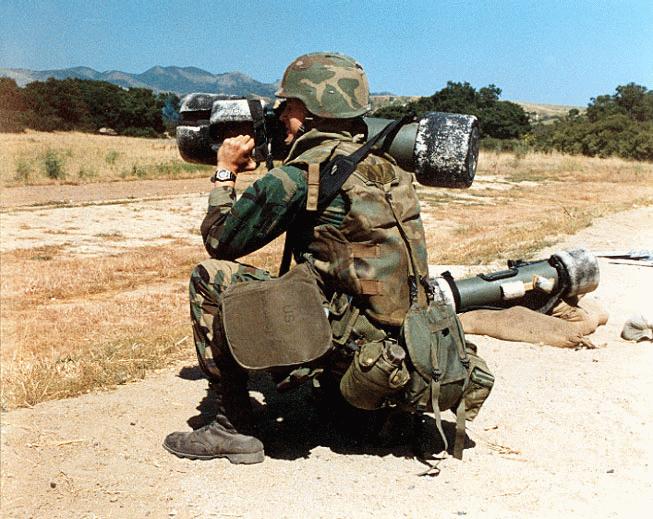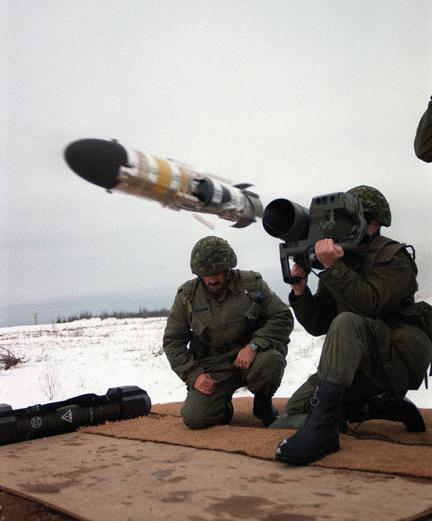FINE, YOU WANT FACTS? HERE:
The Predator SRAW is a small solid-fueled rocket powered missile, which is manually aimed and fired from an expendable shoulder launcher. The complete ready-to-fire system including missile and launcher weighs only 9.7 kg (21.4 lb). The motor is a "soft-launch" rocket with a low initial thrust, so that the weapon can be safely fired from enclosed positions. The Predator is a fire-and-forget missile which can be used at ranges between 17 m and 600 m (19 yd to 650 yd) against stationary and moving targets. During aiming, the Predator's inertial reference autopilot detects the angular motion of the target, and during flight the autopilot directs the missile to a position above the predicted target location. The SRAW is armed with a downward-firing top-attack warhead very similar to the BGM-71F TOW 2B, which is activated by a dual-sensor (laser & magnetic) fuze in the missile's nose.
The SRAW (Short-Range Assault Weapon) program was begun by the United States Marine Corps in 1987 as a replacement for existing unguided anti-armour rockets and grenades like the M72 LAW (Light Anti-Armor Weapon) and the M136 AT4.
Between February 1990 and mid-1993, a demonstration/validation phase was conducted by several competing companies, with the first test firings occurring in 1991. In July 1994, the Predator design of Loral (now Lockheed Martin) was selected for the EMD (Engineering and Manufacturing Development) phase.
EMD Phase I (Risk Reduction) was completed in March 1998, and was followed by Phase II (System Evaluation). In January 2002, Lockheed Martin was awarded the first LRIP (Low-Rate Initial Production) contract for Predator, followed by a second one in January 2003. During EMD, a total of about 230 Predator missiles were built, and the two LRIP contracts cover the production of 730 rounds.
SRAW was to be a low-cost complement to the larger and more sophisticated FGM-148 Javelin anti-armour missile, but further procurement after LRIP was cancelled in 2003. In 2004, Lockheed Martin received a contract to refit all remaining Predators to SRAW-MPV (Multi-Purpose Variant) configuration with a new multi-purpose blast-fragmentation warhead. This will convert the missile from an anti-armour to a direct-fire urban warfare weapon, which better fulfills the current needs of the USMC.
The United States Army evaluated a derivative of the Predator SRAW with a multipurpose warhead for its MPIM (Multipurpose Individual Munition) requirement. A variant named Kestrel, with a direct-attack warhead, was unsuccessfully entered in the UK's NLAW (Next Generation Light Anti-Armour) competition.
Designation Note: The Predator should have received an FGM-nnn guided missile designation, but the official Marine Corps nomenclature is SRAW MK 40 MOD 0. The SRAW-MPV will most likely receive a later MOD number.
------------------------------------------------------------------------------------------------------------------------------
he Multipurpose Individual Munition / Short Range Assault Weapon (MPIM/SRAW) is the future answer for effectively defeating personnel in three different environments: behind masonry/brick walls, within earth and timber bunkers and in light armored vehicles. Ideally suited for MOUT environments, MPIM/SRAW will replace the LAW, AT-4, and other light shoulder fired weapons.
In the statement of managers accompanying the conference report on the National Defense Authorization Act for Fiscal Year 1994 (Public Law 103-160) (H. Rept. 103-357), the conferees agreed that the Army should pursue a limited, interim program for procurement of a bunker-defeat munition (BDM). The conferees also agreed that the Marine Corps' short-range anti-armor weapon (SRAW) and the Army's BDM were too similar to justify maintaining separate programs for the long-term. The conferees believed that a long-term solution to the problem should be sought which drew from the SRAW missile and from warhead technology developed in the Army's multi-purpose individual munition (MPIM) program.
The Army decided on a program for a MPIM system that will capitalize on the SRAW's propulsion technology and the MPIM's warhead technology. The SRAW missile, with the MPIM warhead, has the potential to satisfy the Army and Marine Corps requirements to defeat multiple targets, while the original SRAW warhead provides an anti-armor capability.
The MPIM/ SRAW munition consists of a disposable launcher/ carry case equipped with a 2.5X telescopic sight compatible with current and future night vision devices. The shoulder-launched missile consists of a two- stage, soft- launch propulsion system with inertial guidance and explosively- formed penetrator with follow- through grenade warhead. The missile is capable of firing quickly from its carrying configuration and is safely fired from enclosures. The 35-inch, 20-pound disposable weapon has a range out to 500 meters. Internal rate sensors allow Soldiers to aim directly at a moving target and a soft launch capability allows Soldiers to fire from enclosures. The warhead is extremely lethal due to the combination of an explosively formed penetrator with a follow through fragmentation grenade.
The program completed Phase I (Risk Reduction Phase) in March 1998. All Phase I requirements were met on schedule and within budget. Accuracy solution was verified by two successful full missile shots at 500m wall and 200m bunker. MPIM/SRAW executed Phase II (System Qualification) option in May 1998. USMC Predator qualification testing began in August 1998. First unit equipped is scheduled for FY02.

-------------------------------------------------------------------------------------------------------------------------------


